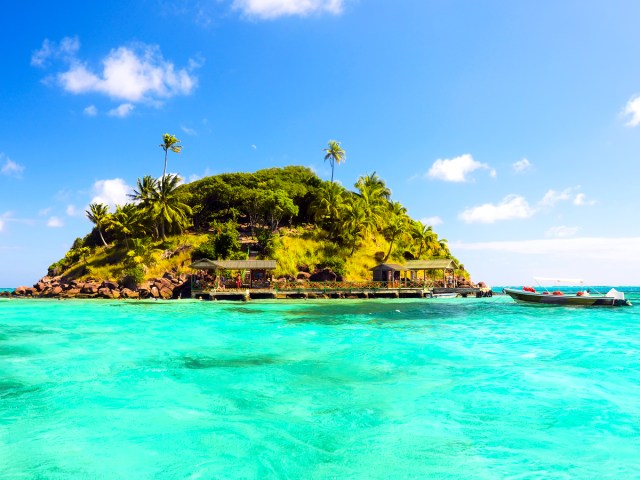Come winter, many places around the world can expect regular snowfall, turning landscapes into sparkling white winter wonderlands. For some, the arrival of snow simply means inconveniences like frozen car windshields and slippery sidewalks, but many others look forward to its striking natural beauty and the start of a season packed with adrenaline-filled winter adventures. If you’re someone who really loves fresh powder, you might want to consider visiting the following places — where living with several feet of snow outside the front door is part of everyday life. Check out 12 of the snowiest places around the globe below.
12. St. John’s, Newfoundland and Labrador, Canada

Average annual snowfall: 132 inches
St John’s, the capital of the Newfoundland and Labrador province, is among the snowiest major cities in Canada. On average, around 132 inches of snow falls on St. John’s every winter. Contributing to this is the city’s location on the country’s exposed and remote eastern coastline. This places St. John’s directly in the path of powerful Atlantic storms, which typically bring blizzards, intense winds, and heavy snowfall. The all-time daily record for the area is 40 inches, which fell on February 13, 1894.
To help residents live comfortably throughout the winter months, the city invests approximately $14.3 million USD in snow clearing and ice control operations each year. Road salt or liquid brine is poured on select roads and pavements to prevent standing water from freezing, thus delaying snow accumulations and minimizing hard-packed snow. Plows are also used to clear streets and can take up to 24 hours to clear completely following a snow event.
11. Chamonix, France
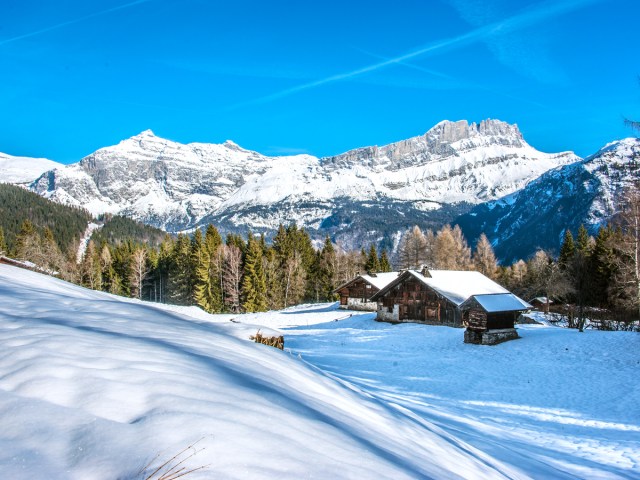
Average annual snowfall: 181 inches
A world-famous ski town set high in the French Alps, Chamonix looks forward to an average of 181 inches of snow each year. This huge annual accumulation is due to the town’s high-altitude setting and an orographic lift effect, in which moist air from the Atlantic rises over towering peaks like Mont Blanc, before cooling and turning into snow. Consistently low temperatures also allow large quantities of snowfall to accumulate and linger throughout the winter.
Straddling the borders of France, Italy, and Switzerland, Mont Blanc towers over the town of Chamonix. This giant massif is measured every two years. The last official reading in 2023 was 15,766 feet (4,805 meters), just over 7 feet shorter than the previous measurement. This variation is due to the amount of ice and snow at the summit, which itself is affected by changes in precipitation and wind.
10. Sapporo, Japan
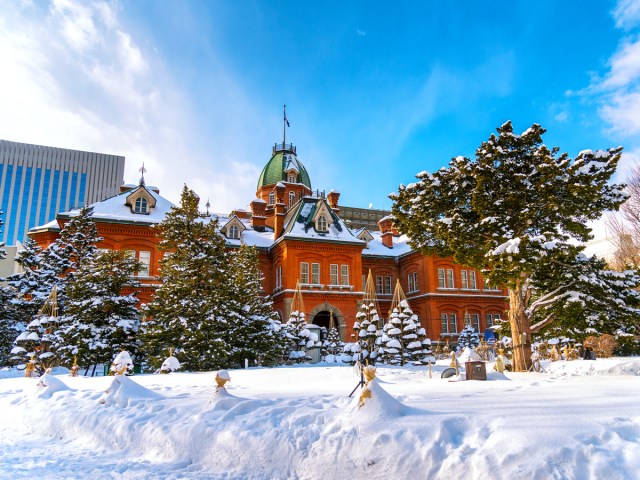
Average annual snowfall: 185 inches
Sapporo is the first of three Japanese cities featured on the list, and one of two located on Hokkaido, the northernmost of Japan’s main islands. Sapporo receives approximately 185 inches of snowfall annually. This is a consequence of both low temperatures in the north and a proximity to the Sea of Japan. In winter, frigid Siberian air flows over the warm Tsushima Current, increasing water vapor and producing clouds that result in heavy snowfall, especially along the coast.
Most of the snow in Sapporo falls between late November and April, a time for excellent skiing conditions. Due to its reliable snowfall, Sapporo was chosen as the host city for the 1972 Winter Olympics. Besides winter sports, Sapporo also makes use of the snow for other reasons: In February, the Sapporo Snow Festival is a magnificent spectacle of snow sculptures and ice slides. It draws artists from across the globe who compete to create the most imaginative and intricate sculptures.
9. Mount Washington, New Hampshire

Average annual snowfall: 281 inches
Towering 6,288 feet above the Presidential Range of the White Mountains, Mount Washington is the tallest peak in New England. Proudly declaring itself the “Home of the World’s Worst Weather,” the mountain boasts meteorological conditions that rival the extremities of Mount Everest and the Sahara Desert. An average of 281 inches fall on the mountain each year, with the snowiest months being December and January. The peak also witnessed one of the fastest wind speeds ever recorded: a stunning 231 mph reading in 1934.
A major factor in its extreme weather is Mount Washington’s location. The peak stands at the confluence of North America’s three major weather fronts: the Atlantic, Gulf, and Pacific Northwest. At the summit sits the Mount Washington Observatory, where a team of meteorologists have been recording the weather patterns since 1932. Educational programs offer a glimpse into their work and the frequently harsh conditions experienced at the top.
8. Aomori City, Japan
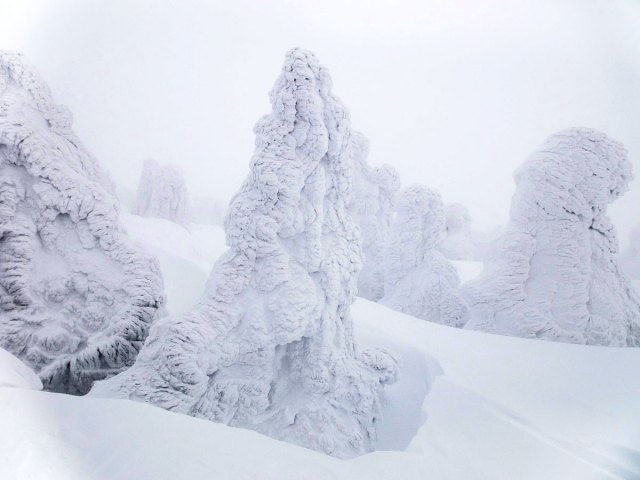
Average annual snowfall: 312 inches
Aomori City sits on the northernmost coastline of Japan’s island of Honshu, between the Hakkoda Mountains and Mutsu Bay. With around 312 inches of snow falling each year, it ranks among the snowiest cities in Japan. The main cause of the frequent snow is the city’s mountain and coastal setting. When winds blow in from different directions, from the peaks and the sea, they collide to create clouds. The precipitation generated by these clouds then turns to snow because of the cold temperatures.
During the winter months, the Hakkoda-Towada Gold Line, part of Japan’s national highway that runs by Aomori, is closed to traffic. Snow plows and bulldozers are used to build the five-mile-long Hakkoda Walk, creating a brilliant white corridor framed by soaring snow walls. Other ways to enjoy this winter wonderland include the Hirosaki Castle Snow Lantern Festival and Lake Towada Winter Story Festival.
7. Kirkwood Mountain, California
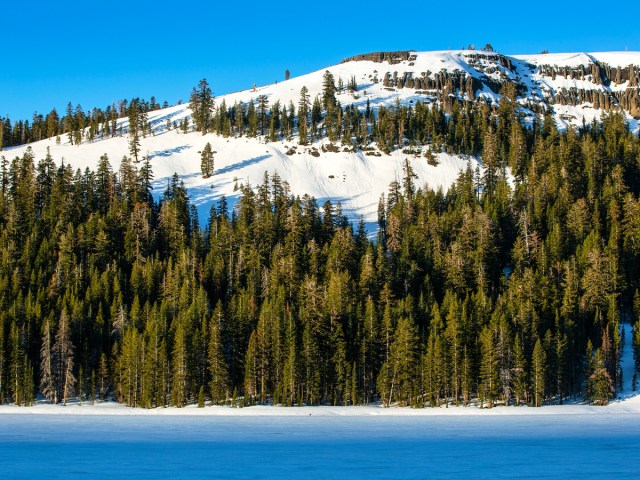
Average annual snowfall: 354 inches
While California is typically known for its sun-drenched coastal towns, parts of the Golden State receive some of the heaviest snowfall in the United States. The majority of it falls in the Sierra Nevada, specifically around the Lake Tahoe area.
Kirkwood mountain receives an average of 354 inches annually due to its location in the Lake Tahoe Basin and a weather phenomenon called the K-factor. When moisture-filled air from the Pacific is forced upward by the mountain, it cools and condenses to generate snowfall. As a result, the mountain is home to one of California’s best ski resorts. There are 86 trails and 2,300 skiable acres spread over five peaks, all accessible via 15 lifts.
6. Shirakawa-go, Japan
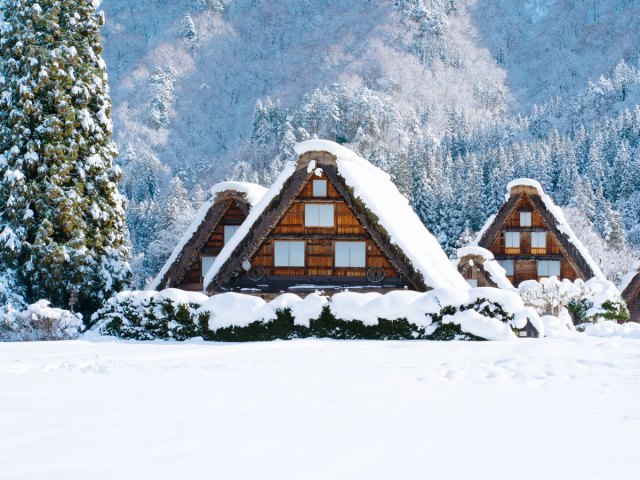
Average annual snowfall: 400 inches
The picturesque village of Shirakawa-go is enveloped by mountains in a once-wild and unexplored region of central Honshu. Between December and February, clouds rise above the lofty Japanese Alps before dumping a massive amount of snow on the village — to the tune of around 400 inches annually.
Alongside its winter blanket of white, Shirakawa-go is famous for its 100-plus gasshō-zukuri homes. Designed to withstand the elements, they feature traditional steep, thatched, and triangular roofs that resemble clasped hands (gasshō-zukuri). The UNESCO-listed Historic Villages of Shirakawa-go and Gokayama have the only remaing examples of these houses in Japan.
While often causing difficulties for local residents, Shirakawa-go’s snowfall makes it a tourism hotspot. On select weekends throughout January and February, the synchronized illuminations of Shirakawa-go Light-Up turn the village into a scene from a fairy tale. Because of the event’s popularity, visitor numbers are limited and advanced reservations are a must. Those who attend can expect spectacular views from Shiroyama Viewpoint and opt to stay overnight in a gasshō-zukuri.
5. Alta, Utah
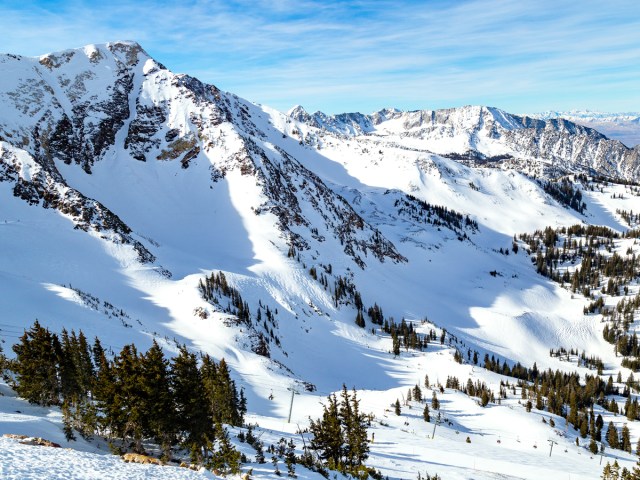
Average annual snowfall: 546 inches
One of Utah’s most popular ski resorts, the Alta Ski Area is sandwiched between the Wasatch Mountains to the east and the Great Salt Lake to the west. When winter storms roll in, the lake supplies abundant moisture to these systems, and its high salt concentration prevents the moisture from freezing. The typical northwesterly direction of the storms creates a more powdery snowfall than at nearby Brighton and Deer Valley. Since statistics were first recorded in 1980, the resort has witnessed an average of 546 inches a year.
Established as a silver mining town in the 1860s, Alta rose to fame as a winter resort when the Alta Ski Area was unveiled in 1938. Today, the resort boasts 119 runs and 2,614 skiable acres, of which 45% is geared toward intermediate and beginner levels. The highest amount of snowfall witnessed in Alta was 903 inches in the 2022-2023 season.
4. Thompson Pass – Alaska
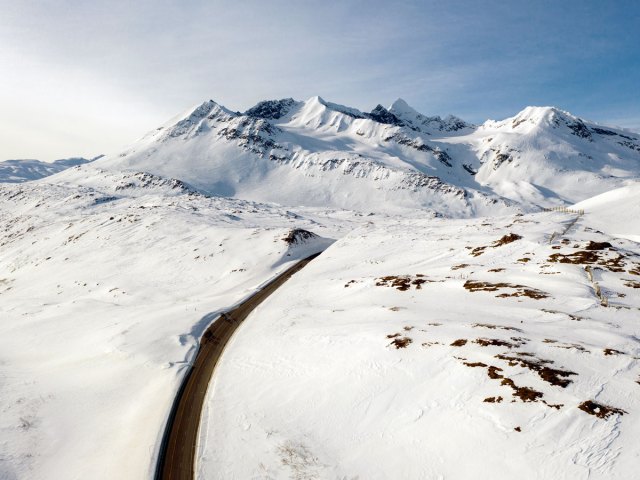
Average annual snowfall: 552 inches
Alaska is synonymous with cold weather — what would be a record-breaking snow day in many areas of the United States is often just a normal winter day in the northernmost state. Nestled amid the Chugach Mountains, Thompson Pass is Alaska’s snowiest spot. A combination of warm ocean currents and cold mountain air creates over 550 inches of snow each year. During the winter of 1952 to 1953, a staggering 974 inches fell in Thompson Pass. And in late December 1955, a storm dumped a whopping 120 inches in just 48 hours.
At the top of the pass, a team of specialists works tirelessly to free the Richardson Highway of snow and ice. This makes the area accessible to adrenaline seekers who come for heli-skiing, skiing, snowboarding, and other winter pursuits. Held in March and April, the Alaska Tailgate attracts snowboarders with 10 days of unbeatable backcountry freeriding. Those not quite up for the challenge of Thompson Pass can experience incredible volumes of snow in nearby Valdez. The city in the foothills of the Chugach Mountains records an average of 330 inches annually.
3. Mount Fidelity, British Columbia, Canada

Average annual snowfall: 560 inches
Situated in the Selkirk Mountains of British Columbia’s Glacier National Park, Mount Fidelity is one of the snowiest places in Canada. Data collected at a weather station on the mountain has recorded an average annual snowfall of 560 inches between 1965 and 2024. The highest seasonal snowfall recorded was almost 850 inches in the winter of 1966-1967. Along with measuring snowfall in the area, the station collects real-time data on temperatures, precipitation, and wind speed. This helps meteorologists monitor the chance of avalanches.
Mount Fidelity is located close to Rogers Pass, a high-altitude mountain pass that cuts through the Selkirk Mountains between Revelstoke and Golden. Once part of the Canadian Pacific Railway, it’s now part of the Trans-Canada Highway. Around 4,000 vehicles and between 24 and 32 trains travel through the pass every day in winter, but heavy snowfall causes up to 100 highway closures per year.
2. Niseko, Japan
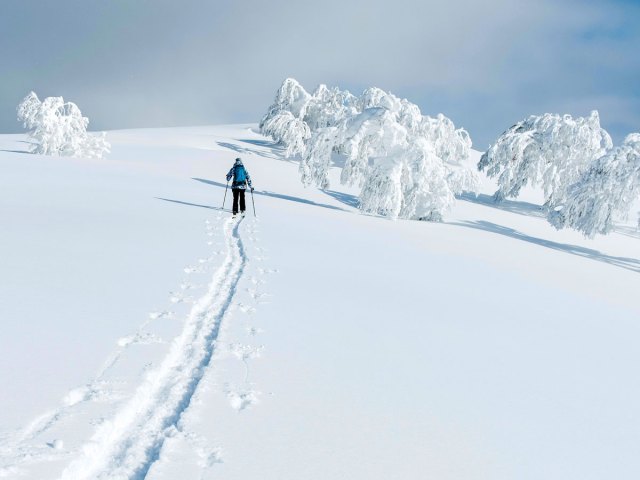
Average annual snowfall: 590 inches
The mountainous regions of the island of Hokkaido island are some of the snowiest areas of Japan. One particularly snowy locale is the village of Niseko, which expects up to 590 inches most winters. The key elements which contribute to this staggering snowfall include a cold Siberian air mass, moisture from the Sea of Japan, sub-zero temperatures at sea level, and the presence of coastal mountains.
All this fresh powder creates near-perfect skiing and snowboarding conditions in Niseko. Niseko United promises downhill escapades at four interconnected ski resorts spread across 4,921-feet-tall Mount Niseko Annupuri. Many skiers hope to experience the “Niseko Express,” when a north-westerly weather pattern drops around two- to six-inch top-ups of snow during the day. A selection of 20 onsen hot springs provide an ideal setting for après-ski relaxation.
1. Mount Rainier National Park – Washington
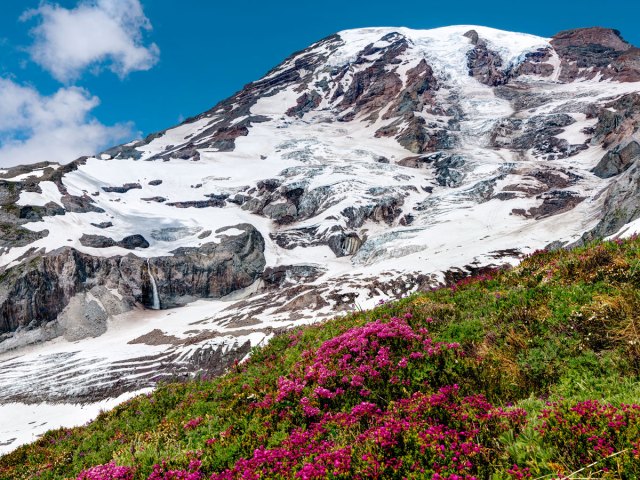
Average annual snowfall: 645 inches
On the south slope of Mount Rainier, the Paradise area once held the world record for snowfall in a single season. In the winter of 1971 to 1972, a mind-boggling total of 1,112 inches was recorded here. According to official records, over 600 inches have fallen on more than 50 occasions since 1922. A combination of low-pressure systems arriving from the Gulf of Alaska, cyclonic circulation in the atmosphere, and the warmer air of the lower mountains make the region susceptible to blizzards.
Due to road closures, Mount Rainier National Park is predominantly a summer destination. That said, the mystical mountain landscapes around Paradise are accessible for cross-country skiing and snowshoeing activities. Ranger-led snowshoeing tours depart from Henry M Jackson Visitor Center and offer an insight into the ecology of Mount Rainier. Other areas of interest during the colder months are the forests around Longmire, which afford views of the mountain and gurgling mineral springs.
More from our network
Daily Passport is part of Inbox Studio, which publishes content that uplifts, informs, and inspires.













